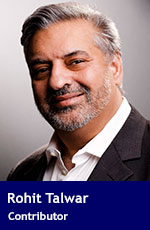 Sixth-generation (6G) wireless communications technology, expected by 2030, could offer the potential for truly transformative applications and functionality because of the higher capacity and lower delay time between sending and receiving voice or data over the network (latency). The anticipated microsecond latency of 6G communications will make it 1,000 times faster than the millisecond latency of the 5G networks currently being rolled out.
Sixth-generation (6G) wireless communications technology, expected by 2030, could offer the potential for truly transformative applications and functionality because of the higher capacity and lower delay time between sending and receiving voice or data over the network (latency). The anticipated microsecond latency of 6G communications will make it 1,000 times faster than the millisecond latency of the 5G networks currently being rolled out.
So, what could this make possible for tomorrow’s workplaces and how we work?
Here are some examples of what working life could look like and the new businesses and business models that could emerge in a 6G world.
The sheer capacity and speed of 6G mean that the boundaries between what can be done at home and in the workplace will be further obliterated. The 6G promise is one of similar quality of access to applications, video, and other content from wherever we are.
By 2030 our computing and communications devices will be potentially 1,000 times more powerful than what we have today. Alongside our laptops, tablets, and smartphones, we could see body-embedded devices becoming commonplace. In parallel, many inanimate surfaces, such as our clothing, tabletops, and car seatbacks, could all be bought to life as multi-functional devices in our computing ecosystem.
 |
| Related Stories |
| We are just scratching the surface of metaverse activity
|
| How artificial intelligence will change our world
|
| 10 principles for future leaders |
Such ‘any time, anywhere, any device’ processing power will only reach its true potential with 6G and the generations that follow it.
Adding technologies such as artificial intelligence (AI) to the management of 6G and in our devices means that our AIs will constantly be learning about what, how, where, and when we do what we do. They would then be able to communicate with AI of the 6G networks to make sure we get access to the applications and data we need just when we need them.
Advances in DNA storage will combine with 6G to create mind-blowing possibilities. Huawei estimates that one day one kilogram of DNA will be able to store all of the information ever created on the planet. Imagine a doctor being able to download and store the details of every cancer case in history to a ring on their finger – in order to run real-time analysis of a current patient’s symptoms and test results – on their smartphone.
Much is made of the potential of metaverses, with Citi estimating that a US$13 trillion ‘meta economy’ could emerge by 2030. This will require 6G capabilities to enable hundreds of millions of simultaneous users to access multiple different metaverses in parallel – with photo-realistic 3D graphics being rendered almost instantaneously. This means a banking assistant could visualize a client’s entire account history and resolve complex service issues and requirements face to face with the customer inside a metaverse. All of this could be done via the agent’s smartphone or watch while out for a walk.
While virtual reality (VR) is still in its infancy and has been slow to take off, a combination of the metaverse opportunity and the emergence of multi-sensory capabilities will transform many aspects of how we work and live using VR. True 6G will enable superfast communication of the massive volumes of data required to convey touch, smell, and taste sensations across the planet.
For example:
- A master chef in Sri Lanka will be able to sample and advise on the aroma, taste, and texture of the creations of their trainees based in Venezuela and London.
- Destinations will be able to offer virtual multi-sensory experiences of stroking a whale, climbing Everest, or dining at an underwater restaurant for travellers who can’t or won’t fly.
- A retailer’s sofa buyers would be able to feel and smell the materials, test the strength, and assess the comfort of designs from multiple factories around the world without ever leaving home.
G6 could also take leisure experiences to the next level. A spectator watching a skiing event in person or remotely would be able to experience all of the body sensations of their favourite skier on a breathtaking jump. The athlete’s boy movements would be captured using sensors on his body, with the signals transmitted at 6G speeds to local and remote audiences. Viewers could also choose to capture those micro-moments as a limited edition multi-sensory NFT so they can relive the experience and sell it as a digital collectible.
Clearly, 6G offers countless brain-bending possibilities when combined with other exponentially advancing technologies such as AI and next-generation devices. From a customer perspective, this could open up the potential for ever more immersive experiences, including truly personalized real-time service from wherever they are on the planet.
From an organizational perspective, G6 has the potential to further blur the work/life boundary and yield new challenges and performance measures. Management receiving moment-by-moment performance information could lead to ‘micro-management’ developing a whole new meaning.
Rohit Talwar is a global futurist and CEO of foresight agency Fast Future. He advises corporations, investors, governments, and NGOs around the world. Rohit focuses on how to anticipate and prepare for the economic, societal, technological, political, and environmental forces and factors that could shape our world.
For interview requests, click here.
The opinions expressed by our columnists and contributors are theirs alone and do not inherently or expressly reflect the views of our publication.
© Troy Media
Troy Media is an editorial content provider to media outlets and its own hosted community news outlets across Canada.

